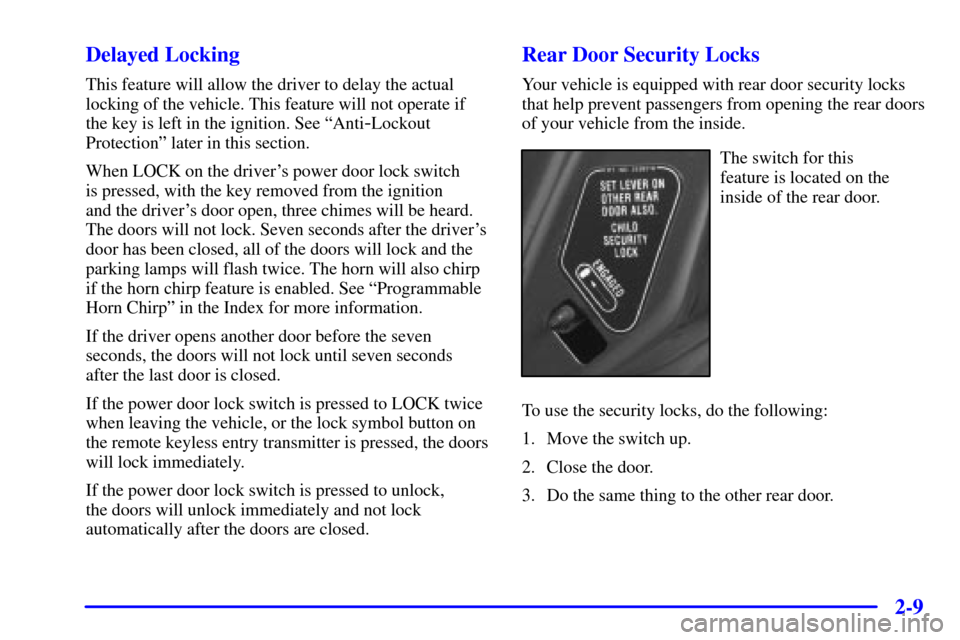Page 59 of 341
1-53
6. To tighten the belt, feed the shoulder belt back
into the retractor while you push down on the child
restraint. You may find it helpful to use your knee
to push down on the child restraint as you tighten
the belt.
7. Push and pull the child restraint in different
directions to be sure it is secure.
To remove the child restraint, just unbuckle the vehicle's
safety belt and let it go back all the way. The safety belt
will move freely again and be ready to work for an adult
or larger child passenger.
Page 72 of 341

2-9 Delayed Locking
This feature will allow the driver to delay the actual
locking of the vehicle. This feature will not operate if
the key is left in the ignition. See ªAnti
-Lockout
Protectionº later in this section.
When LOCK on the driver's power door lock switch
is pressed, with the key removed from the ignition
and the driver's door open, three chimes will be heard.
The doors will not lock. Seven seconds after the driver's
door has been closed, all of the doors will lock and the
parking lamps will flash twice. The horn will also chirp
if the horn chirp feature is enabled. See ªProgrammable
Horn Chirpº in the Index for more information.
If the driver opens another door before the seven
seconds, the doors will not lock until seven seconds
after the last door is closed.
If the power door lock switch is pressed to LOCK twice
when leaving the vehicle, or the lock symbol button on
the remote keyless entry transmitter is pressed, the doors
will lock immediately.
If the power door lock switch is pressed to unlock,
the doors will unlock immediately and not lock
automatically after the doors are closed.
Rear Door Security Locks
Your vehicle is equipped with rear door security locks
that help prevent passengers from opening the rear doors
of your vehicle from the inside.
The switch for this
feature is located on the
inside of the rear door.
To use the security locks, do the following:
1. Move the switch up.
2. Close the door.
3. Do the same thing to the other rear door.
Page 73 of 341

2-10
The rear doors on your vehicle cannot be opened
from the inside when this feature is in use. If you
want to open a rear door while the security lock is on,
do the following:
1. Unlock the door from the inside.
2. Then open the door from the outside.
If you do not cancel the security lock feature, adults or
older children who ride in the rear won't be able to open
the rear door from the inside. You should let adults and
older children know how these security locks work, and
how to cancel the locks.
To cancel a rear door lock, do the following:
1. Unlock the door from the inside and open it from
the outside.
2. Move the switch down.
3. Do the same to the other rear door.
The rear doors will now work normally.Anti-Lockout Protection
Anti-lockout protection is intended to provide enhanced
security and convenience. This feature prevents a driver
who has left the keys in the ignition from locking the
doors, by using the power door lock while any door
is open.
To override this feature, when the key is in the ignition
and any door is open, press down and hold the power
door lock switch for three seconds.
This feature cannot guarantee that you will never be
locked out of your vehicle. If you don't leave the keys
in the ignition, or if you use the manual door lock or
the remote keyless entry transmitter, you could still lock
your keys inside your vehicle. Always remember to take
your keys with you.
Leaving Your Vehicle
If you are leaving your vehicle, open your door and
set the locks from the inside, then get out and close
the door.
Page 80 of 341
2-17 Trunk Release Handle
NOTICE:
The trunk release handle was not designed to be
used to tie down the trunk lid or as an anchor
point when securing items in the trunk. Improper
use of the trunk release handle could damage it.
There is a glow-in-the-dark trunk release handle located
inside the trunk on the trunk latch. This handle will glow
following exposure to light. Pull the release handle up to
open the trunk from the inside.
Trap-Resistant Trunk Kit
To help prevent a child from becoming trapped in your
trunk, you can order a trap
-resistant trunk kit from
your dealer. This kit includes:
�a modified trunk latch,
�a lighted release handle, and
�seatback tethers (for vehicles with folding
rear seatbacks).
See your dealer for additional information.
Page 184 of 341
4-24
Winter Driving
Here are some tips for winter driving:
�Have your vehicle in good shape for winter.
�You may want to put winter emergency supplies in
your trunk.
Include an ice scraper, a small brush or broom, a supply
of windshield washer fluid, a rag, some winter outer
clothing, a small shovel, a flashlight, a red cloth and a
couple of reflective warning triangles. And, if you will
be driving under severe conditions, include a small bag
of sand, a piece of old carpet or a couple of burlap bags
to help provide traction. Be sure you properly secure
these items in your vehicle.
Page 189 of 341
4-29 Dinghy Towing
To tow your vehicle with all four wheels on the ground,
follow these steps:
1. Position the vehicle to tow and then secure it.
2. Turn the ignition switch to OFF.
3. Set the parking brake.4. To prevent your battery from draining while the
vehicle is being towed, remove the following fuses
from the driver's side instrument panel fuse block:
A) Wiper, G) Powertrain Control Module and J)
Body Function Control Module/Cluster. See
ªInstrument Panel Fuse Block
-- Driver's Sideº in
the Index for location of these fuses.
5. Turn the ignition switch to ACC.
6. Shift your transaxle to NEUTRAL (N).
7. Release the parking brake.
Remember to install the fuses once you reach your
destination. To reinstall a fuse:
1. Set the parking brake.
2. Remove the key from the ignition switch.
3. Reinstall the fuse.
Page 193 of 341
4-33
CAUTION:
Do not load your vehicle any heavier than the
GVWR, or either the maximum front or rear
GAWR. If you do, parts on your vehicle can
break, and it can change the way your vehicle
handles. These could cause you to lose control
and crash. Also, overloading can shorten the life
of your vehicle.
CAUTION:
Things you put inside your vehicle can strike
and injure people in a sudden stop or turn, or in
a crash.
�Put things in the trunk of your vehicle. In a
trunk, put them as far forward as you can.
Try to spread the weight evenly.
�Never stack heavier things, like suitcases,
inside the vehicle so that some of them are
above the tops of the seats.
�Don't leave an unsecured child restraint in
your vehicle.
�When you carry something inside the
vehicle, secure it whenever you can.
�Don't leave a seat folded down unless you
need to.
Page 198 of 341

4-38 Driving with a Trailer
Towing a trailer requires a certain amount of experience.
Before setting out for the open road, you'll want to get
to know your rig. Acquaint yourself with the feel of
handling and braking with the added weight of the
trailer. And always keep in mind that the vehicle you are
driving is now a good deal longer and not nearly as
responsive as your vehicle is by itself.
Before you start, check the trailer hitch and platform
(and attachments), safety chains, electrical connector,
lamps, tires and mirror adjustment. If the trailer has
electric brakes, start your vehicle and trailer moving and
then apply the trailer brake controller by hand to be sure
the brakes are working. This lets you check your
electrical connection at the same time.
During your trip, check occasionally to be sure that the
load is secure, and that the lamps and any trailer brakes
are still working.
Following Distance
Stay at least twice as far behind the vehicle ahead as you
would when driving your vehicle without a trailer. This
can help you avoid situations that require heavy braking
and sudden turns.
Passing
You'll need more passing distance up ahead when
you're towing a trailer. And, because you're a good deal
longer, you'll need to go much farther beyond the
passed vehicle before you can return to your lane.
Backing Up
Hold the bottom of the steering wheel with one hand.
Then, to move the trailer to the left, just move that hand
to the left. To move the trailer to the right, move your
hand to the right. Always back up slowly and, if
possible, have someone guide you.